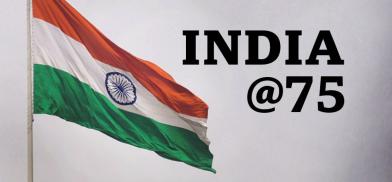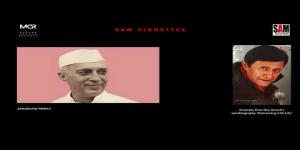India@75 : Much to be proud of, amid some worrisome trends
The ideological shift in politics towards prioritizing the majority religious denomination that has morphed into assertive political Hindutva goes against the fabric of the 'Idea of India' enshrined in the constitution

India at 75 is being celebrated with visible enthusiasm and an ocean of flags – the tricolour or ‘tiranga’ – will flutter proudly across the length and breadth of the country on August 15. This celebratory and infectious ambience is testimony to the achievements, aspirations and resilience of a 1.4 billion citizenry of diverse religion, language and ethnicity and varying socio-economic status, who are all Indian at heart.
An objective review of the journey of the last 75 years would suggest that while there is much to be proud of and the sanctity of the vision of a free and equitable India as envisioned by Mahatma Gandhi and India's first Prime Minister Jawaharlal Nehru is cherished and partially realized, the challenges remain and a new template of the idea of India is being forged. The choices made by the Indian people over the next 25 years will determine what kind of an India – both qualitatively and quantitatively - will usher in India@100.
Taking recourse to the analogy of the Indian glass being both full and empty, the positive aspects of the last 75 years are indeed very impressive and distinctive. Reviewed along three primary tracks – political, economic and military - and relating these tangible attributes of state capability to the ultimate determinant, human security, is instructive.
The political achievement by way of the transition from colonial India to free India on August 15, 1947, though mired in the horrors of partition, remains one of the most remarkable achievements of the 20th century. When the colonial yoke was cast aside, more than 560 princely states that had varying degrees of autonomy were consensually brought into the Indian union and given the complexities of nation-building, This was unprecedented.
At the time, many acerbic critics who were unable to accept the end of colonial rule were disparaging of the Indian resolve and predicted all kinds of doomsday scenarios about the viability of India’s "tryst with destiny". Forging nascent nationhood with the conviction that there could be unity in diversity in a free and unwieldy India was deemed foolish. The fact that India remains wedded to the democratic path - barring the brief emergency period under PM Indira Gandhi - is testimony to the sagacity of the post-1947 Indian leadership and the faith that the citizens reposed in the 'Idea of India'. Today India is the world’s largest democracy and has been held up as a model of a large nation that has managed its diversity with reasonable success – though some recent socio-political trends are cause for concern.
The economic progress of India since 1947 is another domain where the achievements have been commendable. The colonial period was one where the sub-continent was drained of its wealth and techno-industrial capabilities in a ruthless and systematic manner and August 1947 was a case of building the nation’s economic sinews anew.
The first decade was one of arduous internal consolidation and by late 1950, the World Bank estimated that India had a GDP of US $30 billion. Despite sluggish growth, in 2022, India is ranked among the top five global economies and the GDP is over $3 trillion – making this a 100-fold increase. Perhaps this could have been even better – but the economic liberalization ushered by PM P V Narasimha Rao in the early 1990s enabled India to realize its latent potential – but even here the glass could have been more full.
Apropos the impact on human security, the macro results of the last 75 years are cause for satisfaction but not complacence. In the early years after independence, India had almost 80 percent of its population below the poverty line and both food and milk were scarce. There was no middle class – as is now well entrenched – and India did not grow enough grains to feed its millions. The ignominy of living from ‘ship-to-mouth’ with US aid and endemic shortages of normal household gadgets was the dominant characteristic.
In the last five decades, this grim situation has been redressed and India embarked upon two revolutions – green (wheat and rice) and white (milk) – and is now surplus in grain production and among the top producer of dairy products. Dire poverty has been erased but while the numbers have reduced from what they were in the early years, India still has a serious challenge in alleviating poverty among its most deprived classes. Social inequities based on caste, religion and class are tenaciously entrenched in the body politic and the next decade will be critical.
The major gap for India@75 by way of human security indicators is in providing universal education and healthcare to its children and this is a perennial governance challenge. Concurrently gender indicators are below the median and while the government has launched many commendable schemes the implementation is uneven. Yet, the sight of young girls confidently cycling to school in rural and small-town India is cause for quiet cheer and needs to be scaled up.
The military and security domain is also one of commendable progress post-1947. The Indian ‘fauj’ (forces), contrary to the experience of many other post-colonial states, has remained firmly apolitical and professional and this has enabled the consolidation of the democratic orientation of India. The defence of territorial integrity is as challenging in 2022 – as it was in 1962 but the nation is more capable now. In the strategic arena, this has been further enhanced by the manner in which India has acquired its distinctive nuclear weapon status in 1998 and the straetgic rapprochement with the USA in 2008.
Where the water in the Indian glass remains cloudy is the more recent national experience after the BJP emerged as the dominant political party in 2014 and is expected to win a third term in 2024. The ideological shift in politics towards prioritizing the majority religious denomination that has morphed into assertive political Hindutva goes against the fabric of the 'Idea of India' enshrined in the constitution.
While August 1947 heralded a free India where all citizens were equal, a trend towards selective citizenship based on religion that ostracizes the Muslim citizenry is disturbing.
Concurrently, institutional integrity and rigor is being either diluted or compromised and the state is acquiring an intimidatory stance. This is an unhappy augury.
India@75 is at a critical fork in its journey towards August 2047. The texture of its democracy will be shaped by the choice of its citizens and one can only wish the nation well as it navigates the current churn - both domestic and global.
(The author is Director, Society for Policy Studies and an Indian Navy veteran. Views are personal)











Post a Comment